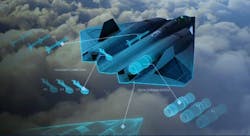Spirit AeroSystems eyes enabling technologies for survivability against integrated air defense systems
ARLINGTON, Va. – U.S. military researchers needed revolutionary enabling technologies for land, sea, air, and space applications that would put U.S. forces far ahead of any potential adversaries. They found their solution from Spirit AeroSystems Inc. in Wichita, Kan.
Officials of the U.S. Defense Advanced Research Projects Agency (DARPA) in Arlington, Va., announced a $13 million contract to Spirit AeroSystems last week for the Redefining Possible project.
Potential U.S. adversaries such as Russia and China have developed ways to counter today's U.S. military systems that are built around exquisite, monolithic integrated systems. Instead, DARPA researchers are asking Spirit AeroSystems to develop revolutionary system architectures that are separate, dispersed, disruptive, and that instill doubt in U.S. adversaries.
DARPA experts want to identify promising technologies and move them quickly to the next phase of research and development. Spirit AeroSystems will develop technologies to improve resilience, responsiveness, range, lethality, access, endurance, and affordability to enable new joint force warfighting concepts.
For aircraft, researchers point out that stealth and low-observability technologies simply do not offer the advantages they used to. Adversaries have come up with generations of countermeasures since stealth was invented, and today the ability to make platforms survivable is approaching physical limits, which makes continuing the traditional path of stealth technologies impractical.
At the same time, unmanned combat air vehicles (UCAVs) have been used widely, and adversaries have developed countermeasures that have compromised the effectiveness of UCAVs and stealth technologies.
DARPA is asking Spirit AeroSystems to enabling technologies to counter the proliferation of advanced integrated air defense systems (IADS) technologies like extremely capable surface-to-air and air-to-air missiles.
The company will develop technologies that provide survivability for next-generation unmanned aerial systems; use distributed and disaggregated systems to reduce reliance on small numbers of exquisite platforms; enable timely delivery of targeting data; advance aircraft propulsion capabilities; machine autonomy to minimize the risk to human warfighters; and design and development tools to develop and field systems quickly, such as model-based systems engineering, multi-dimensional optimization, and additive manufacturing.
Spirit AeroSystems also will consider technologies to improve the integration of unmanned ground systems with one another and with troops to enable both groups to operate together effectively.
DARPA also wants technologies to provide small-unit and individual warfighter mobility and lethality; that can expand combined arms maneuver into the air, into interiors of buildings, and underground. For these technologies DARPA is interested in artificial intelligence (AI) for integrated manned-unmanned ground force operations, ground robots, and ground robotic combat systems to operate at the speed of battle to keep up with human warfighters.
For manned and unmanned surface ships and submarines, DARPA researchers are interested in technologies to reduce reliance on aircraft carriers that require layered air defenses.
For this, researchers want to develop technologies to counter advanced enemy submarines and torpedoes; provide a persistent presence in harsh environments such as the arctic; and small, inexpensive, networked vessels with AI and machine autonomy.
Related: The future of high-performance embedded computing
For space, DARPA researchers are interested in technologies to reduce reliance on large and expensive satellites; AI and deep learning technologies for data evaluation; and counter emerging threats in contested space.
For these kinds of technologies, DARPA researchers want to develop new materials, manufacturing, and computational imaging to reduce the size, weight, cost, and timeliness necessary to field game-changing capabilities.
Several contracts are expected, so additional companies are likely to be involved. For more information contact Spirit AeroSystems online at www.spiritaero.com, or DARPA at www.darpa.mil. The original DARPA Redefining Possible solicitation is online at https://sam.gov/opp/7728a31252544c5da3083c3533c8d50b/view.

John Keller | Editor-in-Chief
John Keller is the Editor-in-Chief, Military & Aerospace Electronics Magazine--provides extensive coverage and analysis of enabling electronics and optoelectronic technologies in military, space and commercial aviation applications. John has been a member of the Military & Aerospace Electronics staff since 1989 and chief editor since 1995.

